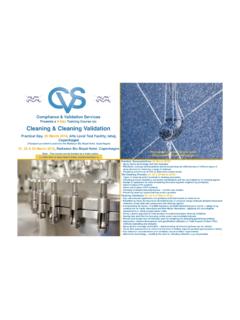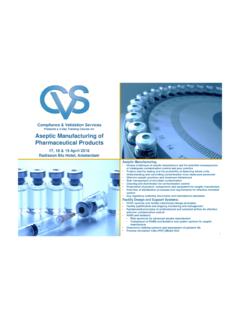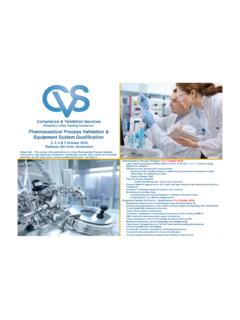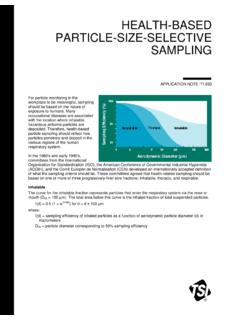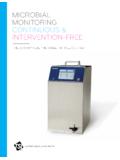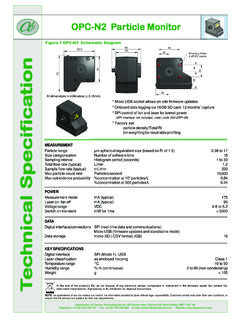Transcription of Presents a 3-Day Training Course on: Restricted …
1 Compliance & Validation Services Presents a 3-Day Training Course on: Restricted access Barrier Systems (RABS). and Isolator technology 24, 25 & 26 April 2018. Radisson Blu Hotel, Amsterdam Key regulations and guidelines Latest industry trends for Aseptic Manufacturing Management of contamination Risk assessments General RABS / Isolators vs. cleanroom operational risk assessments and quantification of risk Uses for RABS and Isolator Systems Types of systems available and key design / operational considerations positive pressure, negative pressure, open or closed, rigid walled and flexible walled Particle monitoring and systems available (including airborne rapid micro sampling). Facility and HVAC system design considerations Development and optimisation of cleaning and sanitisation cycles Photograph courtesy of Equipment, facility and environmental qualification / verification Extract technology Performance qualification of automated H2O2 decontamination cycles Routine testing and maintenance requirements Click on image to visit Website Leak tests, inspection, typical maintenance requirements, Requalification requirements 1.
2 Course Summary: Restricted access Barrier Systems (RABS) and Isolator technology - 24, 25 & 26 April 2018, Radisson Blu Hotel, Amsterdam This Course covers the A-Z of Isolator technology and Restricted access Barrier Systems (RABS) used in Aseptic Manufacturing. It looks at the choices of systems available and the advantages and disadvantages of using Isolators or RABS over traditional Aseptic Manufacturing, together with an overview of all key applicable guidelines, standards and regulations. The Course also covers design (types of systems, ergonomics, air classification and air-flow requirements) and the qualification/verification of the equipment systems involved, including facility and HVAC systems for Isolators/RABS and surrounding/supporting areas. Also included is the development, optimisation and qualification of sanitisation cycles, together with requirements for operation, maintenance, testing, inspection and monitoring of the systems and environments involved.
3 The Course is heavily orientated towards basing decisions for design, qualification/verification, operation and routine monitoring/testing/inspection on risk to product quality and ultimately risk to patient. Presenters Mike James, Director, Compliance & Validation Services Limited.: Mike Industry Expert: Our industry expert has responsibilities for the derivation, has over 24 years experience in the pharmaceutical industry, working in a optimisation and implementation of best practices for aseptically prepared variety of compliance and validation roles. His experience includes products. They have over 20 year's experience of sterile product manufacture preparation and delivery of national/client-based validation Training courses, and have had roles in technical support, production management and specialist hands-on validation work, validation project management and regulatory activities for aseptically prepared products. Our expert has also had pivotal compliance consultancy.
4 Previously, Mike spent four years as the Site involvement in design, construction, start up and validation of multimillion pound Validation Manager for GlaxoSmithKline (GSK) at Speke, where he was aseptic manufacturing facilities. They have also managed the introduction, responsible for all site validation activities, including the development and technical transfer and scale-up activities for a number of sterile products and maintenance of the Site Validation Programme. Before moving to the published a number of papers relating to cleanroom activities. pharmaceutical industry he spent 15 years as an industry chemist. Philip Templeton, Managing Director, Aseptic technology & Design Ltd: Tim Russell, Field Market Developer, TSI Inc.: Tim was one of the founding Phil has over 20 years of aseptic processing experience and speaks Directors of Facility Monitoring Systems Ltd., now integrated into the TSI. regularly on the practical application of isolator and barrier technology with Contamination Control group, specialising in the supply of compliant particular focus on projects involving new developments and validation environmental and particulate monitoring systems.
5 He has 24 years experience techniques. He's previous experience includes client-side project in particle counting instrumentation and associated systems. During this period management for major new facility builds for aseptic processes and Tim has helped design, install and maintain hundreds of compliant monitoring production operations management with Medeva, Celltech and Smith and systems within the Pharmaceutical Industry throughout Europe. Nephew. Phil holds a BSc (Hons) in Bacteriology and Virology from the University of Manchester. Who Should Attend This interactive Course has been designed for personnel from a range of disciplines. These include production, technical, engineering and quality assurance roles. It is aimed at those who are new to Isolator / RABS technology or those who are looking to expand their knowledge in this area. On leaving this Course delegates will: have a better understanding of the types of systems and options available for Aseptic Manufacturing; appreciate the pros / cons and applicability of the different types of systems.
6 Understand key considerations for the design, qualification / verification and operation / maintenance of RABS and Isolator systems; appreciate the different requirements for facility / HVAC systems in supporting areas; be able to apply and share their new knowledge; improve their individual effectiveness and look back on an enjoyable experience. Venue Radisson Blu Hotel, Amsterdam: Ideally situated in the historical heart of Amsterdam, close to the main tourist attractions, museums, theatres, shopping areas, red-light and business districts. The hotel has a fitness center and excellent conference and banqueting facilities. Address: Rusland 17, NL-1012 CK Amsterdam, Netherlands Tel: +31 20 623 1231 Click on the images Fax: +31 20 520 8200 to visit the hotel's website Reservations (email): Delegates are kindly requested to arrange their own accommodation. Course fees are 1, (GBP) per delegate. Accommodation is NOT included in the Course fees.
7 (See Page 4 for further details on fees/bookings) 2. RABS and Isolator technology - Radisson Blu Hotel, Amsterdam - Course Programme: Registration (08:45 to 09:00) Delegates arrive at the meeting room and sign the attendance register. DAY 1 (Tuesday 24 April 2018) Day 2 (Wednesday 25 April 2018) Day 3 (Thursday 26 April 2018). 09:00 Opening/Welcome [Mike James] Day 2 Introduction (09:00) Day 3 Introduction (09:00). Introduction to Cleanrooms, Isolators and RABS [Industry Facility Design Considerations for RABS and Isolators [Industry Automated H2O2 Decontamination Cycles [Phil Templeton]: Expert]: Expert]: Why use automated H2O2 decontamination cycles? History of cleanrooms Regulatory authority considerations Cycle deliverables Classification of controlled environments Layout, flow and personnel entry Properties of H2O2 vapour Achieving and maintaining cleanliness levels Surfaces and finishes Considerations for cycle design Cleanrooms, isolators and RABS for the pharmaceutical General cleanroom fittings Structure of cycle development studies industry Plant room Room decontamination cycles Cleanroom garments for effective control Aseptic behaviours and practices RABS, Key Design and Operational Considerations [Industry Terminal HEPA Filters [Industry Expert]: system Qualification Overview [Mike James]: Expert]: The origins of the HEPA filter system and component level impact summary (what systems Introduction to RABS HEPA filters as a key contamination control method require qualification and what so not).
8 Basic Operating Principles HEPA filter installation leak testing What will adoption of ASTM E2500-07 mean? Types of RABS and RABS Developments Regulatory guidelines for cleanroom HEPA filters Overview of Quality Risk Assessments and how this can be Gaseous Vapour Phase Decontamination HEPA filter in-situ leak testing failure - Group Exercise used to determine level, depth and scope of testing required Interventions and Transfers Typical tests required to qualify systems Operating Systems RABS Selection Matrix Isolator Design Considerations [Phil Templeton]: Cleanrooms, RABS or Isolators [Industry Expert]: PQ of H2O2 Decontamination Cycles [Phil Templeton]: What do we mean by the term isolator? Aseptic Integrity Spectrum Interpretation of BI data Uses and types Assessment of microbial risk to patient from aseptically prepared BI variability Construction materials and compatibility products How should BIs be used Generic isolator sub-systems: Microbial risk during manufacture PQ strategy Air handling systems, sanitisation systems, transfer Microbial risk during shelf life BIs as sensors systems Operational considerations for RABS or Isolators Monitoring and control Ergonomics & Automation Risk Management of Contamination [Industry Expert]: Operational Considerations for Isolators [Phil Templeton]: Routine Testing and Maintenance of Isolators [Phil Fundamental mechanism of contamination Regulatory perspectives Templeton]: Sources of contamination (particularly humans) Product related considerations Leak tests Routes of transfer and risk diagrams Environmental requirements Inspection General RABS/Isolators vs.
9 Cleanroom operational risk What components will need aseptic manipulation Typical maintenance requirements assessments and quantification of risk Hazardous properties Requalification requirements Management/control of risk Manufacturing related considerations What activities will take place inside/outside of the isolator? Transfer mechanisms Particle Monitoring [Tim Russell]: HVAC system Requirements For Surrounding Areas [Mike Environmental Monitoring [Mike James}: How optical particle counters work James]: Typical routine non-viable and viable particle monitoring Particle counting technology (including airborne rapid micro Differences between HVAC requirements for RABS & Isolators requirements for RABS and Isolators sampler and how they work) Typical HVAC system requirements and Considerations for areas Periodic Monitoring requirements Classification v monitoring of clean zones supporting RABS/Isolators Key differences between surrounding environment testing for Classification worked examples Impact of Isolators on the surrounding environment RABS and Isolators FDA CGMP Typical HVAC system control requirements EU GMP Annex 1.]
10 Monitoring systems Understanding particle monitoring data Finish: 17:30; Drinks Reception: 19:00; Course Dinner: 20:00 Finish: 17:00 Finish: 16:40. 3. BOOKING DETAILS: RABS and Isolator technology - 24, 25 & 26 April 2018 Radisson Blu Hotel, Amsterdam How to book on this Course : The simplest and quickest way is to book online. Please visit/return to our web-site, find the Course you are interested in and follow the simple instructions (link included below). Alternatively, download a booking form (complete it electronically or print and annotate) and return it to us by fax or email (link and contact details included below). Or finally, print out this page, complete the form below by hand and return by fax, email or post. << CLICK HERE TO GO TO CVS WEBSITE >> << CLICK HERE FOR BOOKING FORM >>. Fax: +44 (0)1625 800833 Tel: +44 (0)1625 500833 or +44 (0)1270 760882 E-mail: Alternative Booking Form ( *' indicates required fields) Booking Terms & Conditions *Booking Contact Name: Booking Confirmation: A booking confirmation will be sent to the delegate or booking contact on receipt of payment, or in the case of bank *Booking Contact E-mail Address: transfer, following receipt of a valid purchase order reference.
